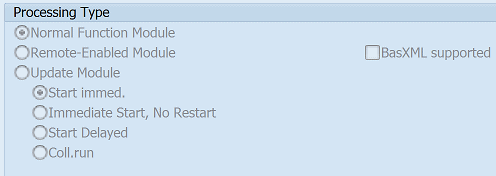SAP UPC_PACKAGE_GET Function Module for Get planning package
UPC_PACKAGE_GET is a standard upc package get SAP function module available within SAP R/3 or S/4 Hana systems, depending on your version and release level. It is used for Get planning package processing and below is the pattern details for this FM, showing its interface including any import and export parameters, exceptions etc. there is also a full "cut and paste" ABAP pattern code example, along with implementation ABAP coding, documentation and contribution comments specific to this or related objects.
See here to view full function module documentation and code listing for upc package get FM, simply by entering the name UPC_PACKAGE_GET into the relevant SAP transaction such as SE37 or SE38.
Function Group: UPC_PACKAGE
Program Name: SAPLUPC_PACKAGE
Main Program: SAPLUPC_PACKAGE
Appliation area: R
Release date: N/A
Mode(Normal, Remote etc): Normal Function Module
Update:

Function UPC_PACKAGE_GET pattern details
In-order to call this FM within your sap programs, simply using the below ABAP pattern details to trigger the function call...or see the full ABAP code listing at the end of this article. You can simply cut and paste this code into your ABAP progrom as it is, including variable declarations.CALL FUNCTION 'UPC_PACKAGE_GET'"Get planning package.
EXPORTING
I_AREA = "Planning Area
I_PLEVEL = "Planning Level
I_PACKAGE = "Planning Package
* I_ENQMODE = "Lock Mode
* I_LANGU = SY-LANGU "SAP R/3 System, Current Language
IMPORTING
E_PACKAGET = "Name of Planning Package
ETO_PACKAGEC = "Characteristics
ETO_PACKAGES = "Characteristic Selections
ETO_PACKAGEH = "characteristic selection with hierarchies
ETO_PACKAGEA = "Attribute Selections
ES_STATINFO = "Statistic Info
ET_DESCRIPTION = "Long Description
EXCEPTIONS
NO_EXISTENCE = 1 LOCKED = 2 NO_CONSISTENCE = 3 PLEVEL_ERROR = 4
IMPORTING Parameters details for UPC_PACKAGE_GET
I_AREA - Planning Area
Data type: UPC_Y_AREAOptional: No
Call by Reference: No ( called with pass by value option)
I_PLEVEL - Planning Level
Data type: UPC_Y_PLEVELOptional: No
Call by Reference: No ( called with pass by value option)
I_PACKAGE - Planning Package
Data type: UPC_Y_PACKAGEOptional: No
Call by Reference: No ( called with pass by value option)
I_ENQMODE - Lock Mode
Data type: ENQMODEOptional: Yes
Call by Reference: No ( called with pass by value option)
I_LANGU - SAP R/3 System, Current Language
Data type: SY-LANGUDefault: SY-LANGU
Optional: Yes
Call by Reference: No ( called with pass by value option)
EXPORTING Parameters details for UPC_PACKAGE_GET
E_PACKAGET - Name of Planning Package
Data type: UPC_Y_PACKAGETXTOptional: No
Call by Reference: Yes
ETO_PACKAGEC - Characteristics
Data type: UPC_YTO_CHAOptional: No
Call by Reference: Yes
ETO_PACKAGES - Characteristic Selections
Data type: UPC_YTO_CHARSELOptional: No
Call by Reference: Yes
ETO_PACKAGEH - characteristic selection with hierarchies
Data type: UPC_YTO_HIESELOptional: No
Call by Reference: Yes
ETO_PACKAGEA - Attribute Selections
Data type: UPC_YTO_ATTRSELOptional: No
Call by Reference: Yes
ES_STATINFO - Statistic Info
Data type: UPC_YS_STATINFOOptional: No
Call by Reference: Yes
ET_DESCRIPTION - Long Description
Data type: UPC_YT_DESCLINEOptional: No
Call by Reference: Yes
EXCEPTIONS details
NO_EXISTENCE - Planning package does not exist
Data type:Optional: No
Call by Reference: Yes
LOCKED - Planning package is locked
Data type:Optional: No
Call by Reference: Yes
NO_CONSISTENCE - Planning package is inconsistent
Data type:Optional: No
Call by Reference: Yes
PLEVEL_ERROR - Error in planning area
Data type:Optional: No
Call by Reference: Yes
Copy and paste ABAP code example for UPC_PACKAGE_GET Function Module
The ABAP code below is a full code listing to execute function module POPUP_TO_CONFIRM including all data declarations. The code uses the original data declarations rather than the latest in-line data DECLARATION SYNTAX but I have included an ABAP code snippet at the end to show how declarations would look using the newer method of declaring data variables on the fly. This will allow you to compare and fully understand the new inline method. Please note some of the newer syntax such as the @DATA is not available until a later 4.70 service pack (SP8), which i why i have stuck to the origianl for this example.| DATA: | ||||
| lv_i_area | TYPE UPC_Y_AREA, " | |||
| lv_e_packaget | TYPE UPC_Y_PACKAGETXT, " | |||
| lv_no_existence | TYPE UPC_Y_PACKAGETXT, " | |||
| lv_locked | TYPE UPC_Y_PACKAGETXT, " | |||
| lv_i_plevel | TYPE UPC_Y_PLEVEL, " | |||
| lv_eto_packagec | TYPE UPC_YTO_CHA, " | |||
| lv_i_package | TYPE UPC_Y_PACKAGE, " | |||
| lv_eto_packages | TYPE UPC_YTO_CHARSEL, " | |||
| lv_no_consistence | TYPE UPC_YTO_CHARSEL, " | |||
| lv_i_enqmode | TYPE ENQMODE, " | |||
| lv_eto_packageh | TYPE UPC_YTO_HIESEL, " | |||
| lv_plevel_error | TYPE UPC_YTO_HIESEL, " | |||
| lv_i_langu | TYPE SY-LANGU, " SY-LANGU | |||
| lv_eto_packagea | TYPE UPC_YTO_ATTRSEL, " | |||
| lv_es_statinfo | TYPE UPC_YS_STATINFO, " | |||
| lv_et_description | TYPE UPC_YT_DESCLINE. " |
| CALL FUNCTION 'UPC_PACKAGE_GET' "Get planning package |
| EXPORTING | ||
| I_AREA | = lv_i_area | |
| I_PLEVEL | = lv_i_plevel | |
| I_PACKAGE | = lv_i_package | |
| I_ENQMODE | = lv_i_enqmode | |
| I_LANGU | = lv_i_langu | |
| IMPORTING | ||
| E_PACKAGET | = lv_e_packaget | |
| ETO_PACKAGEC | = lv_eto_packagec | |
| ETO_PACKAGES | = lv_eto_packages | |
| ETO_PACKAGEH | = lv_eto_packageh | |
| ETO_PACKAGEA | = lv_eto_packagea | |
| ES_STATINFO | = lv_es_statinfo | |
| ET_DESCRIPTION | = lv_et_description | |
| EXCEPTIONS | ||
| NO_EXISTENCE = 1 | ||
| LOCKED = 2 | ||
| NO_CONSISTENCE = 3 | ||
| PLEVEL_ERROR = 4 | ||
| . " UPC_PACKAGE_GET | ||
ABAP code using 7.40 inline data declarations to call FM UPC_PACKAGE_GET
The below ABAP code uses the newer in-line data declarations. This allows you to see the coding differences/benefits of the later inline syntax. Please note some of the newer syntax below, such as the @DATA is not available until 4.70 EHP 8.| "SELECT single LANGU FROM SY INTO @DATA(ld_i_langu). | ||||
| DATA(ld_i_langu) | = SY-LANGU. | |||
Search for further information about these or an SAP related objects